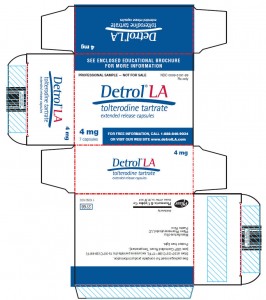In an interesting development the Chennai Patent Office recently revoked Pfizer’s patent on Detrol LA in response to a post grant opposition initiated by Ranbaxy. Detrol LA (extended release capsules of tolterodine) is used for symptomatic treatment of urinary incontinence/overactive bladder syndrome. The revocation order can be accessed here.
Patent status of Detrol LA in India
In India Detrol LA is protected by two patents IN211539 and IN229260 which cover its extended release capsule formulation. It is pertinent to note that there is no patent covering the basic product/parent molecule probably because tolterodine is a pre-TRIPS molecule (a time when India did not grant pharma product patents.)
IN211539 was filed in August 1999 and covers extended release formulation of tolterodine while the second patent IN229260 filed in November 1999 covers an aspect of the extended release formulation of tolterodine and significantly narrower than the earlier patent. Ranbaxy filed a post grant opposition against the later filed patent IN 229260.
What were the grounds raised in the opposition?
25(2)(c)- prior claiming: The opponent submitted that although the claims of IN 211539 and IN 229260 are not exactly identical, the inventive features of the earlier filed patent IN’539 are covered in the later filed IN’260 patent. A comparison of claims of the two patents can be found here.
25(2)(e)-obvious over prior art: Ranbaxy’s counsel submitted that the invention claimed in IN’260 is obvious over prior art.They relied on three prior art documents viz. US4800084, WO98/03067 and WO96/12477 to support their assertion.
Strangely enough Ranbaxy, submitted an interlocutory petition to add an additional ground, apart from the ones mentioned above into the opposition. They argued that the additional ground should be considered under “public interest” and cited excerpts from the IPAB order 250/2012 Sankalp trust vs Hoffman La Roche to support their argument.Thankfully the Controller set aside their “public interest” request and stated that there is no provision in the act to add/amend the opposition grounds after expiry of the prescribed time limit!
Controller’s Decision and my opinion:
Does prior claiming require that the claims in question to be identical?
Prior claiming is different from prior art and this doctrine is relevant in cases where a claim has been claimed in any claim of any other complete specification filed in India, filed before the date of application though published after the date of that application.
The opposition board sided with the patentee and opined that the claims of IN211539 and IN229260 are not identical and that instant patent IN229260 contains additional structural features and claims specific polymers. However the controller stated that all the inventive features of IN’260 were already claimed in the earlier filed patent IN’539 and that the patentee is trying to claim controlled release bead in two different applications. He allowed the opposition under 25(2)(c).
I agree with the Controller in this case and think that rigid standards of similarity should not be adopted for prior claiming.If the claims cover similar technical features and are not patentably distinct then the claims should not be allowed. This is in line with the American doctrines of obviousness type double patenting.
What’s new- isn’t it obvious?
Prior arts: US “084 discloses the use of seal coat between the core and the drug layer in a multilayer medicated formulation.WO 98/03067 discloses method of use of Tolterodine in urinary voiding disorder. This patent discloses various possible formulations of Tolterodine including the controlled release formulation, but does not discuss any formulation in detail.WO96/12477 dicloses a controlled release oral delivery system for oxybutynin,comprising a bead system of core and coatings. Oxybutin is a tertiary amine antiuscarinic used to treat urinary incontinence.
Here again, the opposition board sided with the patentee and opined that inventive skill is involved in selecting quantity of the drug , core medium and compatible polymers for coating to arrive at a controlled release formulation as claimed in the instant patent In 229260.
The controller however found that claims were obvious and stated that the person skilled in the art would have been motivated to prepare a controlled release bead formulation for tolterodine based on prior art teachings and common general knowledge without undue experimentation.
Here I think that the controller’s decision is tainted with hindsight bias. An invention which is obvious to try is not automatically obvious. Obvious to try is obvious only when there is a reasonable expectation of success. In this case I think the prior art only gives general guidance and isn’t’t specific.
Conclusion:
This revocation decision has only reduced the Detrol LA patent term by three months (IN229260 expires on Nov 2019) since the other patent IN211539 is still valid until August 2019.
Since both patents covering Detrol claim the same invention and one of the patents was revoked as being obvious over prior art, the second patent is also vulnerable to revocation under same grounds.
A quick MIMS search reveals that there are several generic versions of Detrol LA existing in the market already. So much for the patent revocation!!


I feel that patent 211539 is more specific wrt dose of tolterodine…
Hi anon, although the ‘539 patent claims a particular dose of Tolterodine, the ‘260
patent is more specific and narrower in scope and claims polymers for use in core and coatings of the controlled release formulation.
I agree
Well written article madhulika great work
Thanks anon 🙂
The last sentence was an interesting revelation. Well ended Madhulika.
You could have added one sentence on what was the additonal grounds that Ranbaxy was trying to include, just for information.
And i agree to your analysis that obvious to try should be further evaluated for motivation to combine and whether there is reasonable expectation of success and then it should be concluded.
As always its interesting to read your articles.
Thanks much Ma’am. The additional ground is not disclosed in the order anywhere.